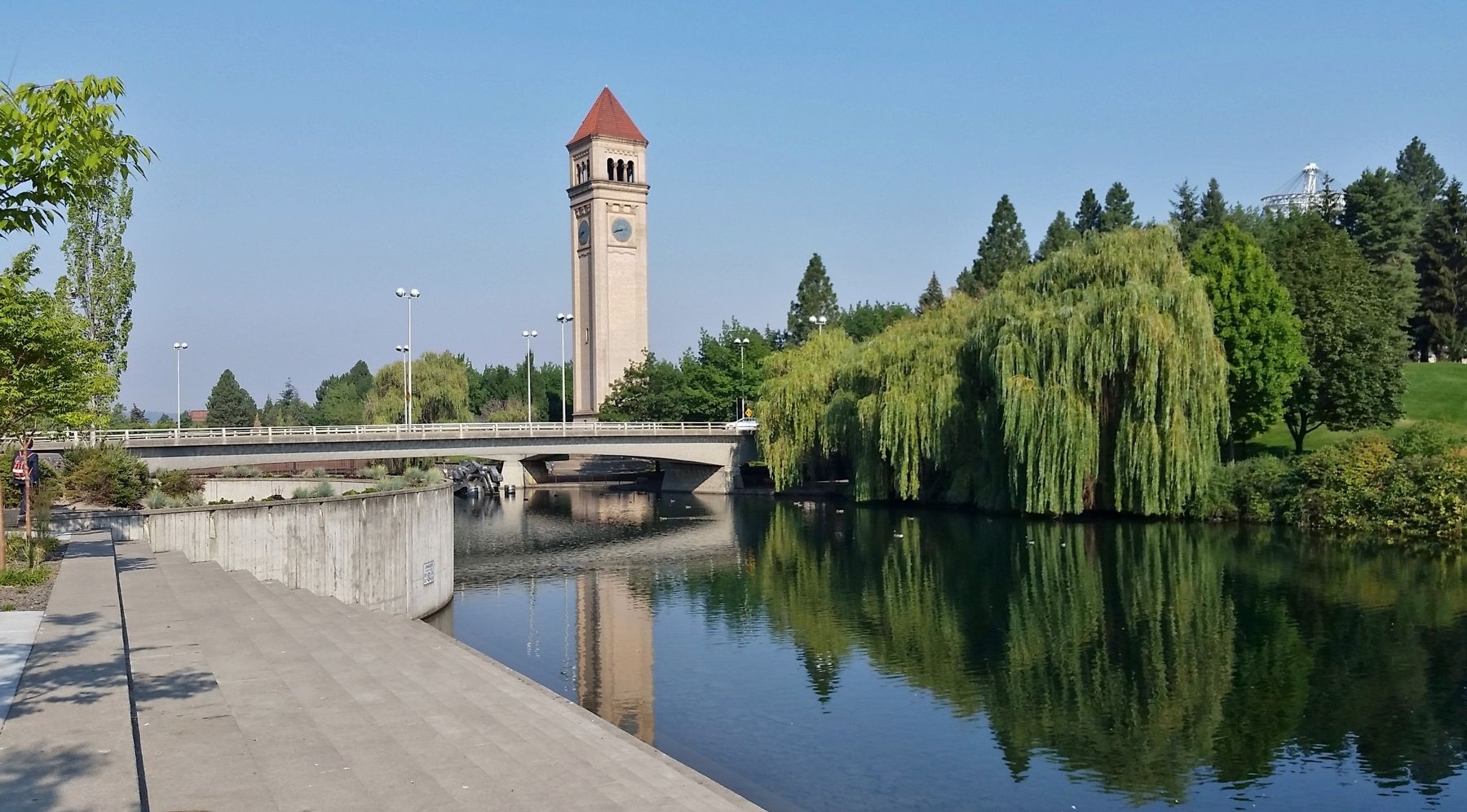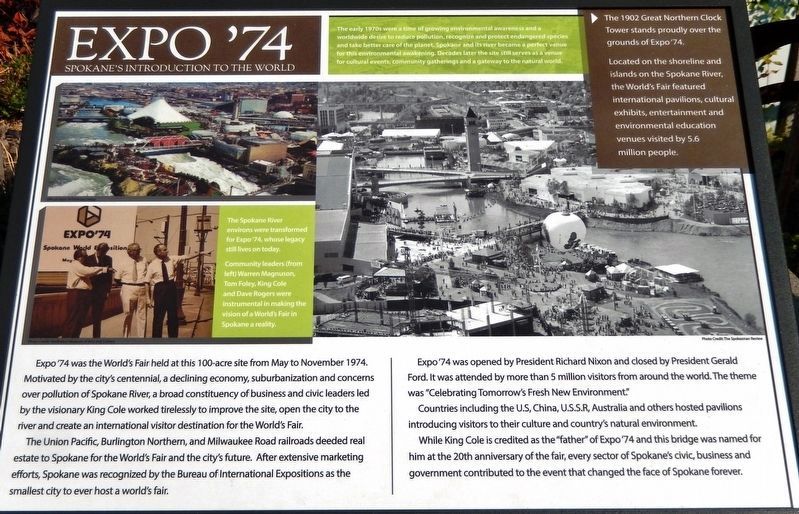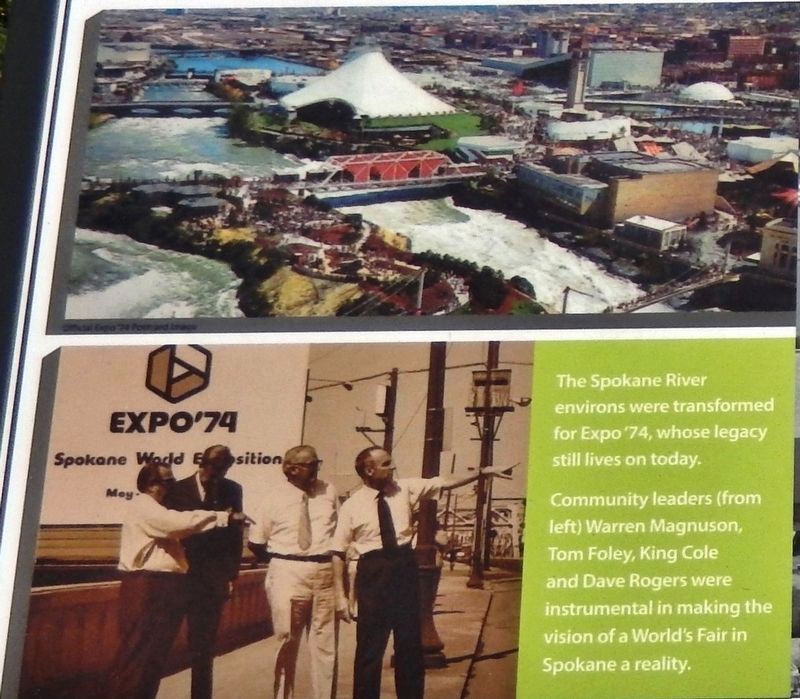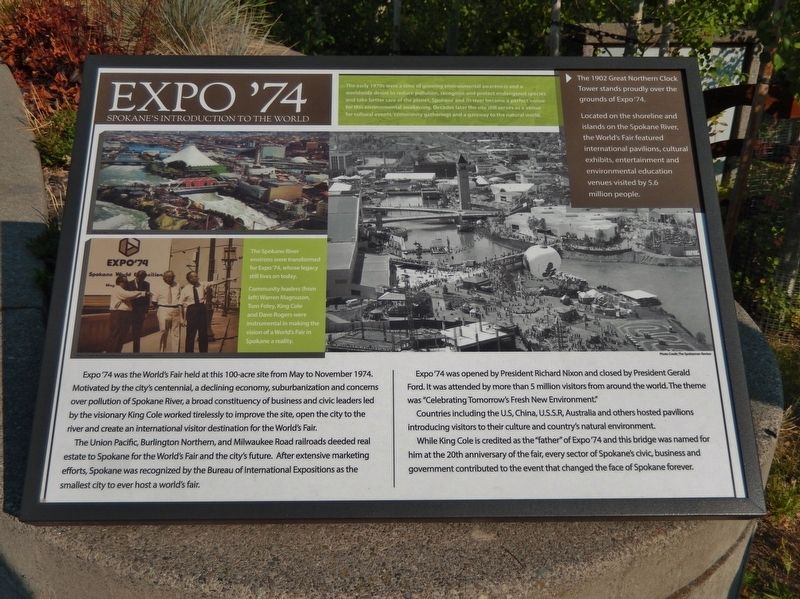Spokane in Spokane County, Washington — The American West (Northwest)
Expo '74
Spokane's Introduction to the World
Expo '74 was the World's Fair held at this 100-acre site from May to November 1974. Motivated by the city's centennial, a declining economy, suburbanization and concerns over pollution of Spokane River, a broad constituency of business and civic leaders led by the visionary King Cole worked tirelessly to improve the site, open the city to the river and create an international visitor destination for the World's Fair.
The Union Pacific, Burlington Northern, and Milwaukee Road railroads deeded real estate to Spokane for the World's Fair and the city's future. After extensive marketing efforts, Spokane was recognized by the Bureau of International Expositions as the smallest city to ever host a world's fair.
Expo '74 was opened by President Richard Nixon and closed by President Gerald Ford. It was attended by more than 5 million visitors from around the world. The theme was “Celebrating Tomorrow's Fresh New Environment.”
Countries including the U.S., China, U.S.S.R., Australia and others hosted pavilions introducing visitors to their culture and country's natural environment.
While King Cole is credited as the “father” of Expo '74 and this bridge was named for him at the 20th anniversary of the fair, every sector of Spokane's civic, business and government contributed to the event that changed the face of Spokane forever.
Topics and series. This historical marker is listed in these topic lists: Environment • Industry & Commerce • Parks & Recreational Areas. In addition, it is included in the Former U.S. Presidents: #37 Richard M. Nixon, and the Former U.S. Presidents: #38 Gerald R. Ford, Jr. series lists. A significant historical year for this entry is 1974.
Location. 47° 39.685′ N, 117° 24.945′ W. Marker is in Spokane, Washington, in Spokane County. Marker can be reached from North Spokane Falls Court, 0.1 miles north of West Spokane Falls Boulevard. Marker is located along the Centennial Trail, overlooking the Spokane River and King Cole Way footbridge. Touch for map. Marker is at or near this postal address: 334 West Spokane Falls Boulevard, Spokane WA 99201, United States of America. Touch for directions.
Other nearby markers. At least 8 other markers are within walking distance of this marker. Washington State Pavilion (within shouting distance of this marker); A Legacy of Railroads (about 300 feet away, measured in a direct line); Industry on the Spokane River
(about 300 feet away); An Evolving Shoreline (about 400 feet away); What's in the Water (about 700 feet away); How the River Became Home for Sqelix — Spokane Tribe (about 700 feet away); Spokane's Evolving Riverfront (about 800 feet away); Great Northern Railway Passenger Depot Clock Tower (approx. 0.2 miles away). Touch for a list and map of all markers in Spokane.
Also see . . .
1. Expo '74 (Wikipedia). With the exception of two pavilions, all of the major buildings were modular structures assembled on the site. The fair had 5.2 million visitors and was considered a success, nearly breaking even, revitalizing the blighted urban core, and pumping an estimated $150 million into the local economy and surrounding region. Expo '74 was the first fair in decades that did not focus on the space age, futuristic themes, or utopian ideas of living. An environmental theme was decided upon by the organizing committee, however there was some uncertainty about it because it had never been used previously by a World's Fair to that time. (Submitted on April 23, 2020, by Cosmos Mariner of Cape Canaveral, Florida.)
2. Industrial to incredible: Expo ’74 spurred beauty of Spokane River. In the 1950s there was a belief that you could throw anything into the river – trash, human waste and more – and it would clean itself within 5 miles. The result was a riverfront that was essentially a trash dump. Spokane had to change this image if it wanted to court the world’s fair, and what it accomplished was transformative. (Submitted on April 23, 2020, by Cosmos Mariner of Cape Canaveral, Florida.)

Photographed By Cosmos Mariner, August 2, 2015
4. The 1902 Great Northern Clock Tower
The 1902 Great Northern Clock Tower stands proudly over the grounds of Expo ’74. Located on the shoreline and islands on the Spokane River, the World’s Fair featured international pavilions, cultural exhibits, entertainment and environmental education venues visited by 5.6 million people.
Credits. This page was last revised on October 23, 2021. It was originally submitted on April 22, 2020, by Cosmos Mariner of Cape Canaveral, Florida. This page has been viewed 264 times since then and 57 times this year. Photos: 1, 2, 3, 4. submitted on April 23, 2020, by Cosmos Mariner of Cape Canaveral, Florida.


